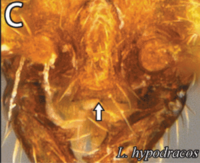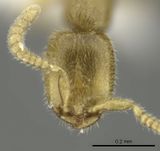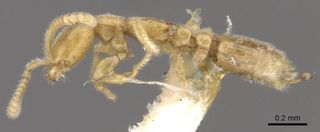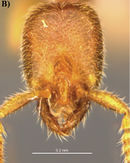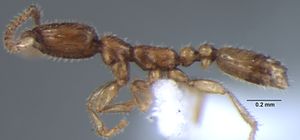Key to Oriental and Sino-Japanese Leptanilla
The following to Asian workers of Leptanilla is based on Bharti and Kumar (2012), Wong and Guénard (2016), Leong et al. (2018) and Saroj et al. (2022).
1
- Masticatory margin of mandible with 2 teeth => 2
- Masticatory margin of mandible with 3 teeth or more => 3
2
return to couplet #1
- Anterolateral lobes of clypeus present. 3rd antennal segment with a distinct basal peduncle. Dorsal view of petiolar node with arched anterior margin. Promesonotal suture narrow => Leptanilla kebunraya
- Anterolateral lobes of clypeus absent. 3rd antennal segment without distinct basal peduncle. Dorsal view of petiolar node rectangular. Promesonotal suture wide => Leptanilla butteli
3
return to couplet #1
4
return to couplet #3
- Full face view of 3rd abdominal tergum weakly narrow in its anterior part (posterior margin al-most one half times as wide as anterior margin, and as long as its width (see Fig. 32 in Baroni- Urbani, 1977). The basal tooth of masticatory margin of mandible very small and difficult to distinguish => Leptanilla japonica
- Full face view of 3rd abdominal tergum strongly narrow in its anterior part (posterior margin more than two times as wide as anterior margin, and distinctly longer than its width (see Fig. 33 in Baroni-Urbani, 1977). The basal tooth of masticatory margin of mandible distinct => 4a
4a
return to couplet #4
- Postpetiole trapezium shaped and posteriorly truncated (Japan) => Leptanilla tanakai
- Postpetiole with equal width at anterior and posterior margin; posteriorly not truncate (India) => Leptanilla ujjalai
5
return to couplet #3
6
return to couplet #5
- In full-face view head approximately rectangular. Clypeus not protruding, with anterior margin roundly convex. In profile view dorsum of petiole almost straight. In dorsal view postpetiolar node much wider than petiolar node. Smaller species; HW: ca. 0.180 mm => Leptanilla hunanensis
- In full-face view head distinctly narrowed anteriorly. Clypeus protruding, with anterior margin concave. In profile view dorsum of petiole roundly convex. In dorsal view postpetiolar node as wide as petiolar node. Larger species; HW: ca. 0.370 mm => Leptanilla kunmingensis
7
return to couplet #5
- Anterior margin of clypeus more or less straight or weakly to strongly convex => 8
- Anterior margin of clypeus medially incised, bilobed => 14
8
return to couplet #7
- Clypeus not protruding anteriorly, and with straight or weakly convex anterior clypeal lobe (Fig. 12A) => 9
- Clypeus slightly or strongly protruding anteriorly, and with distinctly convex anterior clypeal lobe (Fig. 12B, C) => 12
9
return to couplet #8
- Ventral margin of petiolar sternite in lateral view without well developed projection => Leptanilla kubotai
- Ventral margin of petiolar sternite in lateral view with well developed and convex projection => 10
10
return to couplet #9
- Petiolar node distinctly wider than long (PI ≥ 138) => 11
- Petiolar node distinctly longer than wide (PI ≤ ca. 81) => Leptanilla morimotoi
11
return to couplet #10
- Postpetiolar node wider than long (PPI = 163–171). Larger species; HW: ca. 0.235 mm => Leptanilla yunnanensis
- Postpetiolar node almost as long as wide (PPI = 88). Smaller species; HW: ca. 0.140 mm => Leptanilla okinawensis
12
return to couplet #8
- Larger species, with petiole longer than 0.13 mm => Leptanilla besucheti
- Smaller species, with petiole shorter than 0.10 mm => 13
13
return to couplet #12
- Ventral margin of petiolar sternite with triangular projection. Subpetiolar process absent. PPI = 122–138; CI ≥ 82; PI = 111–125 => Leptanilla buddhista
- Ventral margin of petiolar sternite with sub-circular projection. Subpetiolar process present as a small and hook like spine. PPI = 80–86; CI ≤ 74; PI = 117–124 => Leptanilla macauensis
14
return to couplet #7
- Petiole in dorsal view with sharp and protruding anterolateral corners, with well concave anterior margin (Fig. 13E, F) => 15
- Petiole in dorsal view with blunt and non-protruding anterolateral corners, with slightly concave to convex anterior margin (Fig. 13 A, B, C, D) => 16
15
return to couplet #14
- Petiolar node almost twice as long as wide (PI = 60). Postpetiolar node almost as wide as long (PPI = 90) (Fig. 13F) Propodeal dorsum and declivity in lateral view meeting at an angular corner. Masticatory margin of mandibles with a long and well-defined basal tooth => Leptanilla hypodracos
- Petiolar node almost as long as wide (PI = 82– 100). Postpetiolar node distinctly wider than long (PPI = 133–137) (Fig. 13E). Propodeal dorsum and declivity in lateral view meeting at a rather rounded corner. Masticatory margin of mandibles without a long and well-defined basal tooth => Leptanilla clypeata
16
return to couplet #14
- Anterior margin of clypeal disc almost as high as the lower level of antennal insertion (Fig. 14A), with shallowly notched anterior lobe => Leptanilla taiwanensis
- Anterior margin of clypeal disc almost highly exceeding the lower level of antennal insertion (Fig. 14B, C), with distinctly bilobed anterior lobe => 17
17
return to couplet #16
- Posterior margin of head deeply concave in full-face view (Fig. 15C) => 18
- Posterior margin of head almost straight in full-face view (Fig. 15A, B) => 19
18
return to couplet #17
- Petiolar node rectangular with slightly concave anterior margin in dorsal view; anterior distinctly shorter than posterior margin. Smaller species; HW: ca. 0.155 mm => Leptanilla oceanica
- Petiolar node square with straight anterior margin in dorsal view; anterior margin as long as pos-terior margin. Larger species; HW: ca. 0.29 mm => Leptanilla lamellata
19
return to couplet #17
- Petiole sternite in lateral view distinctly protruding, with ventral margin bluntly angulate => 20
- Petiole sternite in lateral view indistinctly protruding, with ventral margin almost straight => Leptanilla thai
20
return to couplet #19
- Masticatory margin of mandible with a total of 3 teeth; basal tooth short and not well-defined. Anterolateral corners of petiole roundly convex in dorsal view (Fig. 13A). HW: ca. 0.245 mm => Leptanilla havilandi
- Masticatory margin of mandible with a total of 4 teeth; basal tooth long and well-defined. An-terolateral corners of petiole forming a small and sharp angle in dorsal view (Fig. 13D). HW: ca. 0.280 => Leptanilla escheri
References
- Baroni Urbani, C. 1977c. Materiali per una revisione della sottofamiglia Leptanillinae Emery (Hymenoptera: Formicidae). Entomol. Basil. 2: 427-488.
- Bharti, H. & Kumar, R. 2012. A new species of Leptanilla (Hymenoptera: Formicidae: Leptanillinae) with a key to Oriental species. Annales Zoologici 62, 619-625.
- Leong, C.-M., Yamane, S., Guenard, B. 2018. Lost in the city: discovery of the rare ant genus Leptanilla (Hymenoptera: Formicidae) in Macau with description of Leptanilla macauensis sp. nov. Asian Myrmecology 10: e010001, pp. 1-17 (doi:10.20362/am.010001).
- Saroj, S., Mandi, A., Dubey, A.K. 2022. A new species of the rare ant genus, Leptanilla Emery (Hymenoptera: Formicidae) from Eastern Himalaya, India. Asian Myrmecology 15, e015005 (doi:10.20362/am.015005).
- Wong, M.K.L., Guénard, B. 2016. Leptanilla hypodracos sp. n., a new species of the cryptic ant genus Leptanilla (Hymenoptera, Formicidae) from Singapore, with new distribution data and an updated key to Oriental Leptanilla species. ZooKeys 551: 129–144 (doi:10.3897/zookeys.551.6686).





